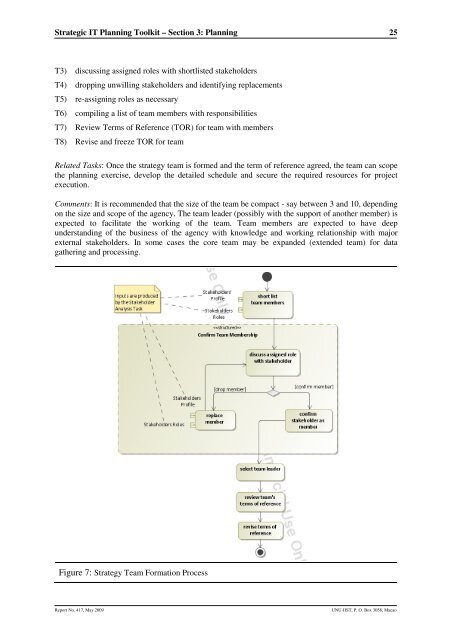Strategic IT Planning for Public Organizations: A Toolkit - UNU-IIST ...
Strategic IT Planning for Public Organizations: A Toolkit - UNU-IIST ...
Strategic IT Planning for Public Organizations: A Toolkit - UNU-IIST ...
Create successful ePaper yourself
Turn your PDF publications into a flip-book with our unique Google optimized e-Paper software.
<strong>Strategic</strong> <strong>IT</strong> <strong>Planning</strong> <strong>Toolkit</strong> – Section 3: <strong>Planning</strong><br />
25<br />
T3) discussing assigned roles with shortlisted stakeholders<br />
T4) dropping unwilling stakeholders and identifying replacements<br />
T5) re-assigning roles as necessary<br />
T6) compiling a list of team members with responsibilities<br />
T7) Review Terms of Reference (TOR) <strong>for</strong> team with members<br />
T8) Revise and freeze TOR <strong>for</strong> team<br />
Related Tasks: Once the strategy team is <strong>for</strong>med and the term of reference agreed, the team can scope<br />
the planning exercise, develop the detailed schedule and secure the required resources <strong>for</strong> project<br />
execution.<br />
Comments: It is recommended that the size of the team be compact - say between 3 and 10, depending<br />
on the size and scope of the agency. The team leader (possibly with the support of another member) is<br />
expected to facilitate the working of the team. Team members are expected to have deep<br />
understanding of the business of the agency with knowledge and working relationship with major<br />
external stakeholders. In some cases the core team may be expanded (extended team) <strong>for</strong> data<br />
gathering and processing.<br />
Figure 7: Strategy Team Formation Process<br />
Report No. 417, May 2009<br />
<strong>UNU</strong>-<strong>IIST</strong>, P. O. Box 3058, Macao

















